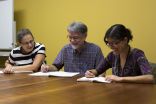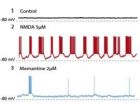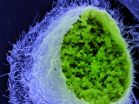(Press-News.org) VIDEO:
The neurons in this video contain a dye that fluoresces when it encounters calcium ions. When the neuron is excited, calcium floods into the cell and the neuron fluoresces. The...
Click here for more information.
Synapse, the name for the signal-receiving site on a neuron, comes from the Greek word for contact. Neuroscientists used to maintain that neurons form one-to-one relationship to contact one another. Yet more researchers are finding evidence that shows how neurons function as part of a network. An incoming excitation does not always provoke an outgoing signal. Some excitations change the state of the neuron, readying the neuron for the next signals. Okinawa Institute of Science and Technology Graduate University researchers in Professor Gordon Arbuthnott's Brain Mechanism for Behavior Unit have just completed a study where they found neurons receiving signals in the area just outside of their synapses, and those signals changed the way that the neurons interpreted the next signals. Led by researchers Marianela Garcia-Munoz and Violeta Lopez-Huerta, the results offer insight on a mechanism reputed for triggering cell death, and the work was published online in Neuropharmacology on September 18, 2014.
For years, neuroscientists thought only the synapse could contain receptors, the neurotransmitter catching-mitts on neurons. But when they applied a neurotransmitter called NMDA to the area around the synapse they realized that they could trigger different responses. Any receptor located near, but not on the synapse, became known as an extrasynaptic receptor. However, stimulating extrasynaptic receptors sometimes triggers a molecular pathway that kills the neuron. Yet extrasynaptic receptors puzzled Professor Arbuthnott, who reasoned that it does not make evolutionary sense to have a group of receptors that act only as self-destruct buttons. "Maybe there are things you can do with this path," he said.
Garcia-Munoz and Lopez-Huerta looked for the extrasynaptic receptors' purpose by first targeting slices of brain. The slices they used connected the striatum, part of the brain involved in movement, to the cortex, which they knew signals to the striatum. However, when they tried to provoke the striatum by stimulating the cortex, the striatal neurons were silent. Next, they added the neurotransmitter NMDA to the brain slice, where NMDA would interact with both synaptic and extrasynaptic receptors. This changed the sensitivity of the neuron by lifting the membrane potential, or the charge of the neuron. The higher the membrane potential, the less additional stimulation a neuron requires to fire an action potential. With the higher membrane potential in place, the researchers could trigger many action potentials. Finally, Garcia-Munoz and Lopez-Huerta added memantine, an Alzheimer's drug that slows the progression of dementia by blocking extrasynaptic receptors, and thus blocking the pathway that triggers cell death. With the memantine in effect and the extrasynaptic receptors out of commission, the researchers could only trigger a few action potentials using electricity. In this way, the researchers could tell that the extrasynaptic receptors were necessary to lift the membrane potential of the striatal cell, putting it in a more sensitive state.
Next, Garcia-Munoz and Lopez-Huerta used calcium imaging to watch how extrasynaptic receptors changed the neural network. When a neurotransmitter interacts with a receptor, the cell opens gated channels. This allows positively charged calcium ions to enter through the cell's membrane, lifting the membrane potential. Garcia-Munoz and Lopez-Huerta added a dye to the system so that when calcium ions enter the cell, they interact with the dye, causing that cell to fluoresce. "Because the calcium is a direct measure of the electrical activity, you can see when the neuron is activated," Lopez-Huerta explained. "We can see the activity of hundreds of cells at the same time," she said. "Like fireflies," Garcia-Munoz added. Then, the researchers once again applied memantine to block the extrasynaptic receptors. The neurons fluoresced far less frequently and less synchronously.
Based on these experiments, Garcia-Munoz and Lopez-Huerta concluded that the extrasynaptic receptors were essential for establishing a plateau, a relatively long 200-millisecond lift in the membrane potential. Although plateaus do not cause action potentials, which last closer to one millisecond, the lift in electric charge gives the neuron a kind of leg up. In fact, Arbuthnott says that the plateau appears necessary for signaling. "The cells in the striatum don't fire action potentials unless they're up and in some kind of plateau state," said Arbuthnott. If this is the case for other parts of the brain, which the group thinks is possible, extrasynaptic receptors are essential for communication brain-wide. As Arbuthnott concluded, "If you need this plateau, you might need these extrasynaptic receptors."
INFORMATION:
VIDEO:
The movement of bone marrow B cells was limited in the absence of VCAM-1, as shown in this time-lapse video. B cells (green) were tracked before (left) and after (right)...
Click here for more information.
Newly formed B cells take the easy way out when it comes to exiting the bone marrow, according to a study published in The Journal of Experimental Medicine.
For infection-fighting T and B cells to defend the body, they must first leave their birthplace--the thymus for ...
This news release is available in German.
Infections due to the sexually transmitted bacterium Chlamydia trachomatis often remain unnoticed. The pathogen is not only a common cause of female infertility; it is also suspected of increasing the risk of abdominal cancer. A research team at the Max Planck Institute for Infection Biology in Berlin has now observed the breakdown of an important endogenous protective factor in the course of chlamydial infection. By activating the destruction of p53 protein, the bacterium blocks a key protective mechanism of infected cells, ...
Doctors tell us that the frenzied pace of the modern 24-hour lifestyle -- in which we struggle to juggle work commitments with the demands of family and daily life -- is damaging to our health. But while life in the slow lane may be better, will it be any longer? It will if you're a reptile.
A new study by Tel Aviv University researchers finds that reduced reproductive rates and a plant-rich diet increases the lifespan of reptiles. The research, published in the journal Global Ecology and Biogeography, was led by Prof. Shai Meiri, Dr. Inon Scharf, and doctoral student ...
If you want to see into the future, you have to understand the past. An international consortium of researchers under the auspices of the University of Bonn has drilled deposits on the bed of Lake Van (Eastern Turkey) which provide unique insights into the last 600,000 years. The samples reveal that the climate has done its fair share of mischief-making in the past. Furthermore, there have been numerous earthquakes and volcanic eruptions. The results of the drilling project also provide a basis for assessing the risk of how dangerous natural hazards are for today's population. ...
WASHINGTON, D.C. - Two or more serious hits to the head within days of each other can interfere with the brain's ability to use sugar - its primary energy source - to repair cells damaged by the injuries, new research suggests.
The brain's ability to use energy is critical after an injury. In animal studies, Ohio State University scientists have shown that brain cells ramp up their energy use six days after a concussion to recover from the damage. If a second injury occurs before that surge of energy use starts, the brain loses its best chance to recover.
In mice, ...
Mikhail Kosiborod, M.D., of Saint Luke's Mid America Heart Institute, Kansas City, and colleagues evaluated the efficacy and safety of the drug zirconium cyclosilicate in patients with hyperkalemia (higher than normal potassium levels). The study appears in JAMA and is being released to coincide with its presentation at the American Heart Association's Scientific Sessions 2014.
Hyperkalemia is a common electrolyte disorder which can cause potentially life-threatening cardiac arrhythmias and is associated with chronic kidney disease, heart failure, and diabetes mellitus. ...
BLOOMINGTON, Ind. -- An Indiana University-Dartmouth College team has identified genes and regulatory patterns that allow some organisms to alter their body form in response to environmental change.
Understanding how an organism adopts a new function to thrive in a changing environment has implications for molecular evolution and many areas of science including climate change and medicine, especially in regeneration and wound healing.
The study, which appears in the journal Molecular Biology and Evolution, provides insight into phenotypic plasticity, a phenomenon that ...
November 17, 2014, PORTLAND, Ore. -- People who received automated reminders were more likely to refill their blood pressure and cholesterol medications, according to a study published today in a special issue of the American Journal of Managed Care.
The study, which included more than 21,000 Kaiser Permanente members, found that the average improvement in medication adherence was only about 2 percentage points, but the authors say that in a large population, even small changes can make a big difference.
"This small jump might not mean a lot to an individual patient, ...
This news release is available in Spanish.
Although maize was originally domesticated in Mexico, the country's average yield per hectare is 38% below the world's average. In fact, Mexico imports 30% of its maize from foreign sources to keep up with internal demand.
To combat insect pests, Mexican farmers rely primarily on chemical insecticides. Approximately 3,000 tons of active ingredient are used each year just to manage the fall armyworm (Spodoptera frugiperda), in addition to even more chemicals used to control other pests such as the corn earworm (Helicoverpa ...
In the aquatic environment, suction feeding is far more common than biting as a way to capture prey. A new study shows that the evolution of biting behavior in eels led to a remarkable diversification of skull shapes, indicating that the skull shapes of most fish are limited by the structural requirements for suction feeding.
"When you look at the skulls of biters, the diversity is astounding compared to suction feeders," said Rita Mehta, assistant professor of ecology and evolutionary biology at UC Santa Cruz.
With more than 800 species, including both suction feeders ...







